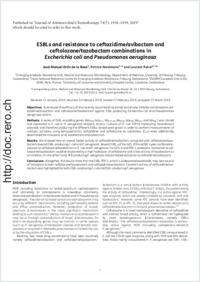ESBLs and resistance to ceftazidime/avibactam and ceftolozane/tazobactam combinations in Escherichia coli and Pseudomonas aeruginosa
- Ortiz de la Rosa, José Manuel Medical and Molecular Microbiology Unit, Department of Medicine, Faculty of Science, University of Fribourg, Switzerland
- Nordmann, Patrice Medical and Molecular Microbiology Unit, Department of Medicine, Faculty of Science, University of Fribourg, Switzerland - Department of Medicine, INSERM European Unit (IAME, France), University of Fribourg, Switzerland - Department of Medicine, Swiss National Reference Center for Emerging Antibiotic Resistance (NARA), University of Fribourg, Switzerland - Department of Medicine, Institute for Microbiology, University of Lausanne and University Hospital Centre, Lausanne, Switzerland
- Poirel, Laurent Medical and Molecular Microbiology Unit, Department of Medicine, Faculty of Science, University of Fribourg, Switzerland - Department of Medicine, INSERM European Unit (IAME, France), University of Fribourg, Switzerland - Department of Medicine, Swiss National Reference Center for Emerging Antibiotic Resistance (NARA), University of Fribourg, Switzerland
-
01.07.2019
Published in:
- Journal of Antimicrobial Chemotherapy. - 2019, vol. 74, no. 7, p. 1934–1939
English
To evaluate the efficacy of the recently launched β-lactam/β-lactamase inhibitor combinations ceftazidime/avibactam and ceftolozane/tazobactam against ESBL- producing Escherichia coli and Pseudomonas aeruginosa strains.Methods: A series of ESBL-encoding genes (blaTEM, blaSHV, blaCTX-M, blaVEB, blaPER, blaGES and blaBEL) was cloned and expressed in E. coli or P. aeruginosa recipient strains. Cultures of E. coli TOP10 harbouring recombinant plasmids and therefore producing the different ESBLs tested were grown in order to perform measurements of catalytic activities, using benzylpenicillin, ceftazidime and ceftolozane as substrates. IC50s were additionally determined for clavulanic acid, tazobactam and avibactam.Results: We showed here an overall better activity of ceftazidime/avibactam compared with ceftolozane/tazobactam toward ESBL-producing E. coli and P. aeruginosa. Several ESBLs of the GES, PER and BEL types conferred resistance to ceftolozane/tazobactam in E. coli and P. aeruginosa. For GES-6 and PER-1 producers, resistance to ceftolozane/tazobactam could be explained by a high hydrolysis of ceftolozane and a low activity of tazobactam as an inhibitor. On the other hand, PER-producing P. aeruginosa also exhibited resistance to ceftazidime/avibactam.Conclusions: Altogether, the results show that the ESBL PER- 1, which is widespread worldwide, may be a source of resistance to both ceftolozane/tazobactam and ceftazidime/avibactam. Excellent activity of ceftazidime/avibactam was highlighted for both ESBL-producing E. coli and ESBL- producing P. aeruginosa.
- Faculty
- Faculté des sciences et de médecine
- Department
- Médecine 3ème année
- Language
-
- English
- Classification
- Biological sciences
- License
- License undefined
- Identifiers
-
- RERO DOC 326990
- DOI 10.1093/jac/dkz149
- Persistent URL
- https://folia.unifr.ch/unifr/documents/307940
Other files
Statistics
Document views: 63
File downloads:
- nor_erc.pdf: 451
- nor_erc_sm.pdf: 126

